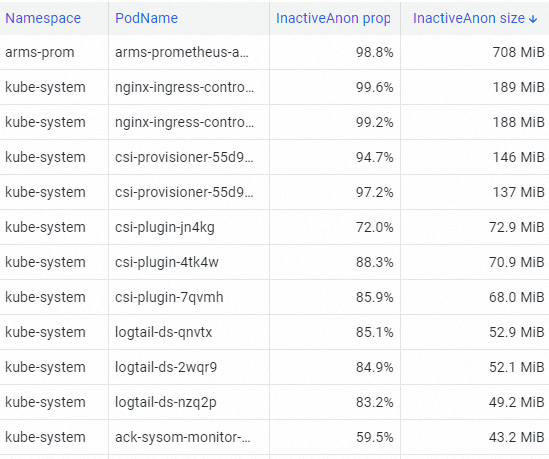コンテナエンジン層はユーザーに透過的ではないため、コンテナサービス障害のトラブルシューティングは困難です。 この問題に対処するために、Container Service for Kubernetes (ACK) はOSカーネルレベルのコンテナーモニタリング機能を提供し、コンテナーエンジン層の信頼性と透過性を高めます。 これにより、コンテナ化されたアプリケーションを効率的に移行できます。 このトピックでは、System Observer Monitoring (SysOM) を使用してコンテナーメモリの問題を特定する方法について説明します。
前提条件
10月2021日以降にACKマネージドクラスターが作成されるか、ACKサーバーレスクラスターが作成され、クラスターのKubernetesバージョンは1.18.8以降です。 クラスターの作成方法の詳細については、「ACK管理クラスターの作成」および「ACKサーバーレスクラスターの作成」をご参照ください。 クラスターを更新する方法の詳細については、「手動でACKクラスターをアップグレードする」をご参照ください。
Prometheusのマネージドサービスが有効になっています。 詳細については、「Prometheusのマネージドサービスの有効化」をご参照ください。
ack-sysom-monitorが有効になっています。 詳細については、「ack-sysom-monitorの有効化」をご参照ください。
ack-sysom-monitorの請求
ack-sysom-monitorコンポーネントを有効にすると、関連コンポーネントは自動的にManaged Service for Prometheusにモニタリングメトリックを送信します。 これらのメトリックはカスタムメトリックと見なされます。 カスタム指標には料金がかかります。
この機能を有効にする前に、課金の概要を読んで、カスタムメトリクスの課金ルールを理解することをお勧めします。 料金は、クラスターサイズとアプリケーション数によって異なります。 リソース使用量の表示の手順に従って、リソース使用量を監視および管理できます。
シナリオ
多くの企業はコンテナ化を使用してITアーキテクチャを構築し、コストを削減し、効率を高め、柔軟性とスケーラビリティを向上させています。
しかしながら、コンテナ化は、コンテナエンジン層の透明性を損ない、メモリ不足 (OOM) の問題などの問題を引き起こす。 Kubernetesのポッドが過剰なメモリを占有し、メモリ使用量が上限を超えると、OOMの問題が発生します。
この問題を解決するために、Container Service for Kubernetes (ACK) チームは、Alibaba CloudのGuestOSチームと協力して、OSカーネルレベルのコンテナモニタリング機能を提供します。 これらの機能は、コンテナーのメモリ使用量をより適切に管理および最適化し、メモリ不足によるOOMの問題を回避するのに役立ちます。
コンテナメモリ
コンテナのメモリは、アプリケーションメモリ、カーネルメモリ、空きメモリで構成されます。
メモリカテゴリ | メモリタイプ | 説明 |
アプリケーションメモリ | アプリケーションメモリは、次のタイプで構成されます。
| 実行中のアプリケーションが占有するメモリ。 |
カーネルメモリ | カーネルメモリは、次のタイプで構成されます。
| OSカーネルが使用するメモリ。 |
フリーメモリ | なし。 | 使用されていないメモリ。 |
仕組み
Kubernetesは、メモリワーキングセットを使用して、コンテナーが占有するメモリを監視および管理します。 コンテナによって占有されるメモリが指定されたメモリ上限を超えた場合、またはノードで使用可能なメモリが不足した場合、Kubernetesは、メモリワーキングセットに基づいてコンテナを削除するか強制終了するかを決定します。 SysOMを使用すると、メモリワーキングセットが大きいポッドを特定し、包括的かつきめ細かい方法でメモリ使用量を監視および分析できます。 このようにして、O&Mエンジニアと開発者は、メモリワーキングセットが大きいポッドをすばやく見つけて修正し、コンテナのパフォーマンスと安定性を向上させることができます。
コンテナのメモリワーキングセットは、ある期間内にコンテナによって占有されるメモリの量を指す。 メモリは、期待どおりに実行するためにコンテナに必要です。 メモリワーキングセット=InactiveAnon + ActiveAnon + ActiveFile。 アプリケーションの匿名メモリの総量は、InactiveAnonとActiveAnonの合計に等しくなります。 ActiveFileは、アプリケーションのアクティブファイルキャッシュのサイズに等しい。
SysOM機能の使用
SysOMのOSカーネルレベルのダッシュボードを使用すると、ポッドやノードのメモリ、ネットワーク、ストレージメトリクスなどのシステムメトリクスをリアルタイムで表示できます。 SysOMメトリックの詳細については、「SysOMに基づくカーネルレベルのコンテナーモニタリング」をご参照ください。
ACKコンソールにログインします。 左側のナビゲーションウィンドウで、[クラスター] をクリックします。
[クラスター] ページで、管理するクラスターの名前をクリックします。 左側のウィンドウで、 を選択します。
[Prometheusモニタリング] ページで、[その他] タブをクリックし、[ACK Sysom Pod Kernel Resource Monitor] タブをクリックして、ポッドのメモリ分布をダッシュボードに表示します。
次の式を使用して、不足しているメモリ問題を見つけます。メモリワーキングセット=InactiveAnon + ActiveAnon + ActiveFile。
SysOMが提供するダッシュボードのPodメモリ分布の円グラフには、OSカーネルレベルのポッドメモリ分布が表示されます。 円グラフのinactive_anon、active_anon、およびactive_fileのメモリタイプのサイズを比較し、最大の割合を占めるメモリタイプを見つけます。
次の図に示すように、inactive_anonメモリタイプが最大の割合を占めます。

[ポッドリソース分析] セクションで、トップコマンドを使用して、クラスター内で最もInactiveAnonメモリを占有しているポッドを見つけます。
次の図に示すように、arms-promポッドは最も非アクティブなAnonメモリを占有します。

[ポッドメモリの詳細] セクションでは、ポッドのメモリ使用量の詳細を表示できます。 ポッドキャッシュ、InactiveFile、InactiveAnon、Dirty memoryなど、ダッシュボードに表示されるポッドのメモリメトリクスに基づいて、ポッド内の一般的なメモリ不足の問題を特定できます。

[ポッドファイルキャッシュ] セクションで、大容量のキャッシュメモリの原因を特定します。
ポッドが大量のメモリを占有すると、ポッドのメモリワーキングセットが実際の使用中のメモリサイズを超える可能性があります。 メモリ不足の問題は、ポッドが属するアプリケーションのパフォーマンスに悪影響を及ぼします。

メモリ不足の問題を修正します。
ACKが提供するきめ細かいスケジューリング機能を使用して、メモリ不足の問題を修正できます。 詳細については、「コンテナーのメモリQoS」をご参照ください。
関連ドキュメント
SysOMメトリックの詳細については、「SysOMに基づくカーネルレベルのコンテナーモニタリング」をご参照ください。
コンテナーのメモリサービス品質 (QoS) 機能の詳細については、「概要」をご参照ください。